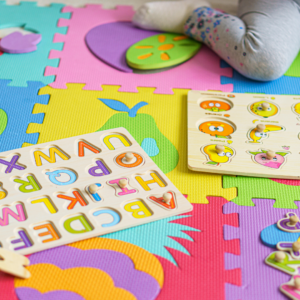What’s great at entertaining kids while developing critical learning skills? Puzzles, of course!
As wonderful as kids puzzles they are for little ones, they can be a chore to maintain and keep organized. If you ask any parent who has dealt with missing pieces, dilapidated boxes, or toppling towers, they’ll tell you what a nightmare puzzles can be.
In addition, how can parents balance their children’s passion for puzzles with the need for order?
Let Mission 2 Organize help you bring it all together so you can enjoy the best of both worlds! With our guidance, you’ll create an organized space where puzzles are both fun and easy to manage.
How 2 Organize Kids’ Puzzles
Although there are many adults who love puzzles and the challenges they present, kids’ puzzles are in a league of their own.
- They can be made of different materials. For beginning puzzle solvers, they are usually made of wood with small plastic grips for easy handling. If they are floor puzzles, they are oftentimes made of foam.
- They have bigger sized pieces for smaller hands to manage.
- They are used or played with more often. This often leads to more wear and tear on the boxes or the puzzles themselves.

Organizing puzzles should be as unique as the kids who enjoy them. Use these six tips to keep things orderly while making puzzles easy for kids to access.
1. Find a location that makes it easy for kids to reach.
First, keep puzzles within your child’s reach rather than storing them out of sight. Unless there’s a choking hazard concern, puzzles should be accessible for play. Storing them at eye level allows kids to take them out and put them away on their own. This not only encourages independence but also helps them develop responsibility for keeping their play area tidy.



2. Use space-saving containers.
Skip the original puzzle boxes and use small stackable plastic containers instead. Just be sure to cut out the picture from the box or take a photo of it to attach to the container or pouch. This way, your child can easily see which puzzle they’re working on!
3. Consider a stacking tower to hold wooden puzzles.
Next, Use a specialized puzzle rack to keep wooden puzzles organized. It’s better when they are held by a structure of some kind because of their unusual sizes and shapes.
4. Create a system.
Because kids often lose puzzle pieces, create systems. Consider creating a tracking system to keep them organized. Assign each puzzle a letter and label its pieces with that letter followed by a number.
As an example, a PAW Patrol puzzle could be labeled “A,” with each piece marked as A1, A2, A3, and so on. This simple system makes it easier to identify where each piece belongs, preventing them from getting lost or mixed up in the playroom.



5. Keep a puzzle inventory checklist.
On the other hand, kids tend to gather a huge list of toys, games, and puzzles. Because of this, keeping an inventory checklist of your puzzles can help you stay organized.
- Tracking where each puzzle was purchased.
- Ensuring all the pieces are accounted for.
- Identifying the correct pouch or container for storage.
- Noting the appropriate age range for each puzzle.
Also Read Our Blog: 4 Home Inventory Platforms and Why You Need One
6. Include kids in the organizing process.
Finally, teach your children to manage their large puzzle collection themselves. Encourage them to take out only one puzzle at a time and put it back in its proper place when finished. Additionally, instilling these organizing habits will soon help them grow into organized adults!



In brief, there’s no denying that kids love doing puzzles. Puzzles are engaging activities alone, with friends, or with family. However, you can make it easy for everyone to enjoy them by implementing these storage and organizing ideas.
For more on how to organize your puzzles kids and yourself, watch our video: How 2 Organize Puzzles
How could these tips help you enjoy and maintain your kids’ puzzles better?









